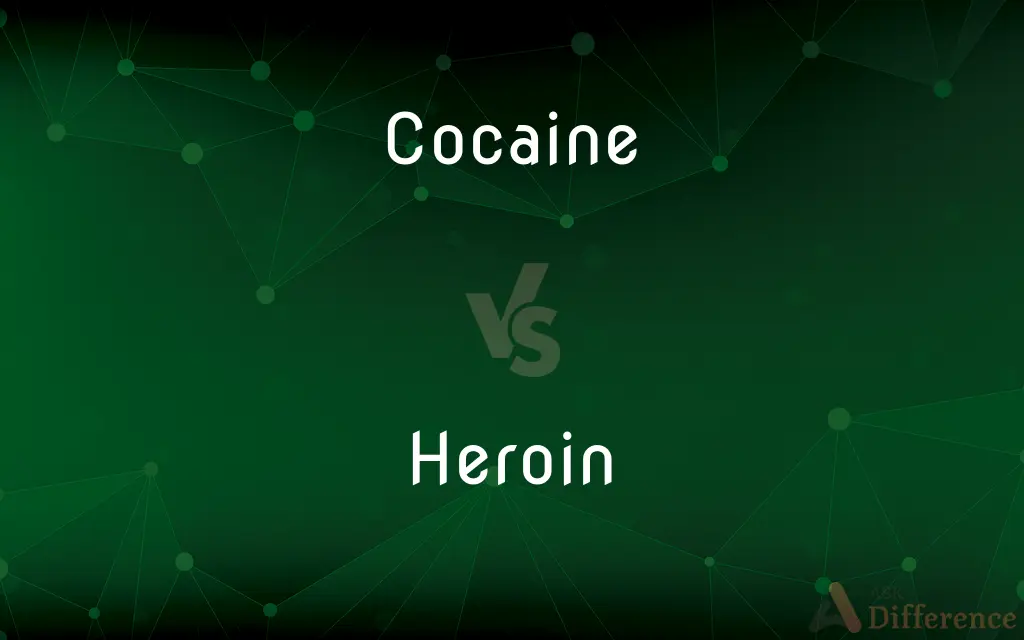Cocaine vs. Heroin — What's the Difference?
By Tayyaba Rehman & Urooj Arif — Published on April 6, 2024
Cocaine is a stimulant that increases alertness, while heroin is an opioid that induces sedation and pain relief.

Difference Between Cocaine and Heroin
Table of Contents
ADVERTISEMENT
Key Differences
Cocaine, a powerful stimulant derived from the coca plant, primarily increases energy levels and feelings of euphoria. On the other hand, heroin, processed from morphine, is a potent opioid known for inducing intense feelings of relaxation and pain relief. Cocaine typically comes in a powder form and is often snorted, whereas heroin can be found in both powder and tar forms and is usually injected, smoked, or snorted.
Cocaine acts quickly upon the central nervous system to increase dopamine levels, leading to its stimulant effects. It can cause a rapid heart rate, increased blood pressure, and heightened alertness. Heroin, conversely, binds to opioid receptors in the brain, slowing down bodily functions, reducing pain perception, and often leading to drowsiness and a state of euphoria.
Cocaine's effects are generally short-lived, lasting from 15 minutes to an hour, necessitating frequent use to maintain its high. Heroin's effects last longer, typically a few hours, leading to prolonged periods of sedation and pain relief. The addiction potential for both substances is high, but heroin's physical dependency develops more quickly due to its powerful effect on the brain's reward system.
The legal consequences of cocaine and heroin use are severe in many countries, reflecting their status as controlled substances. However, the societal impact of heroin is often viewed as more severe due to its stronger association with overdose deaths and its role in the opioid epidemic.
Cocaine users may seek the drug for its ability to increase productivity and euphoria, while heroin users often seek relief from pain or a sense of profound relaxation. The reasons for initial experimentation can vary widely, but both substances are associated with high risks of addiction and detrimental health effects.
ADVERTISEMENT
Comparison Chart
Classification
Stimulant
Opioid
Primary Effect
Increases alertness, energy, and feelings of euphoria.
Induces relaxation, pain relief, and euphoria.
Form
Powder, crack cocaine
Powder, tar
Method of Use
Snorted, smoked, injected
Injected, smoked, snorted
Duration of Effect
Short-term (15 minutes to an hour)
Longer-lasting (a few hours)
Addiction Potential
High, with rapid development of tolerance
Very high, with quick onset of physical dependence
Common Risks
Heart attack, respiratory failure, neurological effects
Overdose, respiratory depression, infectious diseases
Compare with Definitions
Cocaine
Classified as a Schedule II drug in the United States, indicating a high potential for abuse.
Possession of cocaine without a prescription is illegal.
Heroin
Heroin is an opioid drug made from morphine, a natural substance taken from the seed pod of various opium poppy plants.
Heroin is known for its powerful sedative and pain-relieving effects.
Cocaine
Cocaine is a potent central nervous system stimulant derived from the leaves of the coca plant.
Cocaine use can lead to severe psychological and physical effects.
Heroin
Used for its intense euphoric effects, despite its high potential for addiction and overdose.
Many users turn to heroin for the profound relaxation it offers.
Cocaine
Associated with significant societal and health costs, including addiction and overdose.
The fight against cocaine trafficking remains a major challenge for law enforcement.
Heroin
Risks include overdose, infectious diseases from needle sharing, and respiratory depression.
Long-term heroin use can lead to serious health complications.
Cocaine
Can cause cardiovascular and respiratory issues, among others.
Frequent cocaine use may lead to heart problems.
Heroin
Classified as a Schedule I substance in the United States, indicating no accepted medical use and a high potential for abuse.
Selling or possessing heroin is illegal and can lead to severe legal penalties.
Cocaine
Primarily used recreationally for its stimulating effects.
Users often take cocaine for the energy boost it provides.
Heroin
Contributes to the opioid crisis with widespread issues of addiction, overdose deaths, and economic burden.
Efforts to combat the heroin epidemic include increasing access to treatment and naloxone.
Cocaine
A colorless or white crystalline alkaloid, C17H21NO4, extracted from coca leaves, sometimes used in medicine as a local anesthetic especially for the eyes, nose, or throat and widely used as an illicit drug for its euphoric and stimulating effects.
Heroin
A white, odorless, bitter crystalline compound, C21H23NO5, that is derived from morphine and is a highly addictive illegal narcotic. Also called diacetylmorphine.
Cocaine
An addictive drug derived from coca (Erythroxylum) or prepared synthetically, used sometimes medicinally as a local anesthetic and, often illegally, as a stimulant.
Heroin
A powerful and addictive drug derived from opium producing intense euphoria. Classed as an illegal narcotic in most of the world.
Cocaine
A narcotic (alkaloid) extracted from coca leaves; used as a surface anesthetic or taken for pleasure; can become powerfully addictive
Heroin
A narcotic that is considered a hard drug; a highly addictive morphine derivative; intravenous injection provides the fastest and most intense rush
Common Curiosities
How are cocaine and heroin used?
Cocaine is often snorted, smoked, or injected, whereas heroin can be injected, smoked, or snorted.
What are the legal classifications of cocaine and heroin in the United States?
Cocaine is a Schedule II drug, indicating a high potential for abuse but with some medical uses. Heroin is a Schedule I drug, indicating a high potential for abuse with no accepted medical use.
What are the short-term effects of using cocaine?
Short-term effects include increased heart rate, euphoria, increased energy, and potential anxiety.
What is the main difference between cocaine and heroin?
Cocaine is a stimulant that increases energy and alertness, while heroin is an opioid that induces sedation and pain relief.
What are the short-term effects of using heroin?
Short-term effects include pain relief, drowsiness, euphoria, and slowed breathing.
Can cocaine and heroin cause addiction?
Yes, both drugs have a high potential for addiction and dependency.
How does society view the use of cocaine and heroin?
Both are viewed negatively due to their association with addiction, health risks, and legal consequences.
Are there any medical uses for cocaine and heroin?
Cocaine has limited medical uses as a local anesthetic, while heroin has no accepted medical use in the United States.
What are the risks of cocaine use?
Risks include heart attack, stroke, and psychological effects such as anxiety and paranoia.
What is being done to address the issues related to heroin and cocaine?
Efforts include law enforcement to curb trafficking and public health approaches to reduce harm and provide treatment.
What is the duration of effects for cocaine and heroin?
Cocaine effects are short-term, while heroin's effects last longer.
What are the risks of heroin use?
Risks include overdose, infectious diseases from needle sharing, and respiratory depression.
What are the societal impacts of cocaine and heroin use?
Both contribute to public health crises, with significant costs related to healthcare, law enforcement, and social services.
How do cocaine and heroin affect the brain?
Cocaine increases dopamine levels, causing stimulation. Heroin binds to opioid receptors, resulting in sedation.
How does the addiction potential of cocaine compare to heroin?
Both have high addiction potentials, but heroin's physical dependency develops more quickly.
Share Your Discovery

Previous Comparison
Timelines vs. Flow Charts
Next Comparison
Social Norm vs. Social RoleAuthor Spotlight
Written by
Tayyaba RehmanTayyaba Rehman is a distinguished writer, currently serving as a primary contributor to askdifference.com. As a researcher in semantics and etymology, Tayyaba's passion for the complexity of languages and their distinctions has found a perfect home on the platform. Tayyaba delves into the intricacies of language, distinguishing between commonly confused words and phrases, thereby providing clarity for readers worldwide.
Co-written by
Urooj ArifUrooj is a skilled content writer at Ask Difference, known for her exceptional ability to simplify complex topics into engaging and informative content. With a passion for research and a flair for clear, concise writing, she consistently delivers articles that resonate with our diverse audience.
















































